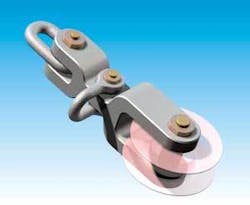Steel grade saves weight on cylindrical FPSO mooring system
Hans-Jürgen Henk - Vicinay Cadenas Northern Europe
A North Sea operator is developing a small oilfield with a cylindrical FPSO, the Sevan Marine-designed SSP. For this first-time application in European waters, the operator/contractor team opted for a permanent mooring system in a line configuration of anchor to chain to polyester rope to chain.
The SSP will be in 120 m of water in the UK Central North Sea. Following extensive discussions regarding the most efficient technical solution, Sevan Marine recently contracted Spanish chain maker Vinicay Cadenas to design and supply the mooring chains and connectors.
To achieve the required characteristics for the mooring chains, Vicinay’s DNV-approved, extra-high tensile steel grade R5 was chosen for both the upper studless chain and the studless seabed chain segments. This grade provides increased load-bearing capacity of 16%, compared to the conventional R4 chain grade in the same dimension. For the upper chain segments, with a nominal diameter of 120 mm and length of 200 m, this also represents total weight savings of around 132,000 kg for the 12-leg mooring system.
| Grade | R4 | R5 |
|---|---|---|
| Min. Tensile Strength [MPa] | 860 | 1000 |
| Min. Yield Stress [MPa] | 580 | 760 |
| Min. Elongation [%] | 12 | 12 |
| Min. Reduction of Area [%] | 50 | 50 |
| Impact Test Temperature [°C] | -20 | -20 |
| Min. Impact Energy, Base [J] | 50 | 58 |
| Min. Impact Energy, Weld [J] | 36 | 42 |
| Increase of Load Bearing Capacity | 16 % |
To save further weight, the seabed chains feature longer links than the standard link length of six times the chain diameter (6d). Vinicay developed this concept - known as Variable Geometry and Weight (VGW) around 10 years ago, and it has since proven successful in numerous offshore projects.
The increase in link length from 6d to 7d provides additional weight savings of roughly 8%. In combination with grade R5, the total savings amount to 24% compared with standard R4 studless chain. For the seabed chain segments, with a nominal diameter of 125 mm and length of 375 m, this results in total weight savings of around 260,000 kg for the 12-leg SSP mooring system.
The combined impact on weight saving for the mooring system should be around 392 metric tons. Even with a slightly higher price for the Grade R5 materials, there is a considerable cost benefit obtained through this level of weight saving.
To prevent the polyester ropes coming into contact with the seabed - and also to improve the mooring line characteristics - a subsea spring buoy is being fitted to each of the mooring lines at the lower connection between polyester rope and seabed chain. The reduced chain weight and a specially designed connector lessens the net buoyancy requirements for the spring buoy, and saves costs.
Both upper and lower connectors between chain and polyester rope are specially designed H-type offshore shackles. These shackles are forged and machined for maximum fatigue performance and lowest possible weight. The lower connector design incorporates a D-type joining shackle to attach the spring buoy assembly.
Vicinay has developed the R5 chain grade in close cooperation with the steel mill and the metallurgical department at the engineering school of the Basque Country University in Bilbao, northern Spain. Extensive research and development, followed by wide-ranging qualification tests and classification society approval testing, resulted in the final recognition of this grade by DNV, ABS, and LRS.
Vicinay has delivered more than 10,000 metric tons of this steel grade - formerly designated R4S+ - over the past two years and more. It has equipped both mobile offshore drilling units and floating production units with these new chains. Currently, more than 45% of the company’s production capacity is taken up with manufacturing R5 mooring chains.




